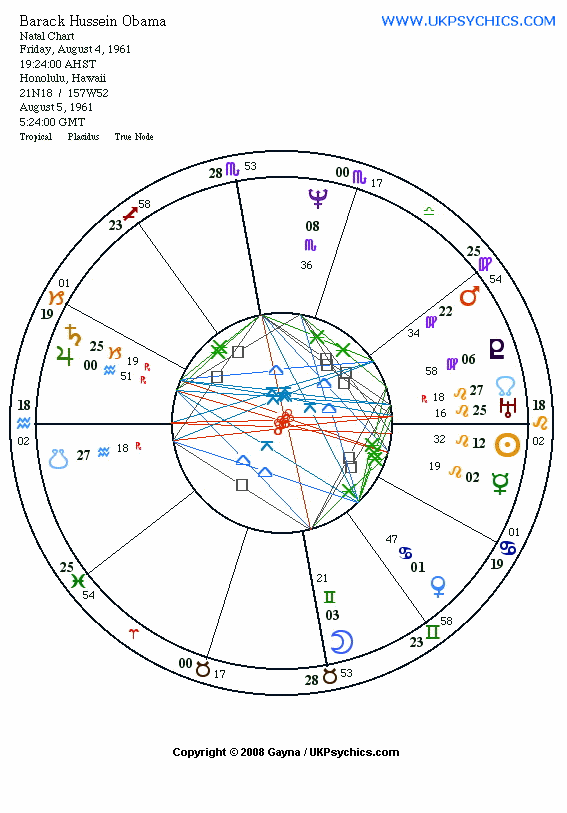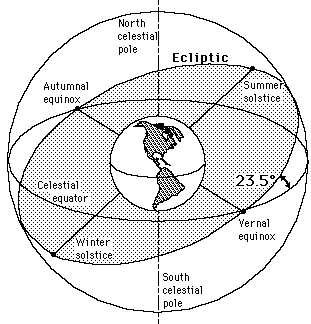I have one answer for mom (and everybody else). And it's a simple one. NO!
This article reports on the "findings" of Park Kunkle, board member of the Minnesota Planetarium Society. Kunkle asserts that the moon's gravitational pull causes the Earth to wobble on its axis, causing the 12 constellations of the zodiac to shift slowly along the ecliptic, a 360 degree circle that traces the path of the Sun as viewed from Earth. In astrology, we often use a two dimensional manifestation of our sky (horoscopes, birth charts, etc.), which is simply a map of the ecliptic. For example...

Barack Obama's natal chart
Let me set the record straight here. This is no discovery. Precessional movement, or simply precession, is a physical term applied to a change in the orientation of the rotational axis of a rotating body. It is a basic principle of physics; it explains why a spinning top cannot remain spinning perfectly upright. Aristarchus of Samos (c. 280 BCE) was the first known astronomer to apply this principle to the Earth, establishing the notion of a variable rotational pattern for our planet.
Now, astrologers may not be scientists, but we're also not stupid. To believe that astrologers have ignored such a fundamental physical truth of astronomy for over 2000 years is... well, it's just plain silly. In fact, precession has been observed and accounted for since the time of Aristarchus.
Wait, so that means that astrologers have known about the shifting constellations, but have ignored it and lied to horoscope readers for thousands of years?
Believe it or not, some people actually believe this.
In fact, Kunkle's findings are completely irrelevant to astrology as we know it. His assertions about the constellations regard the sidereal zodiac, which is based solely on the positions of the stars. The sidereal zodiac is rarely used today, although it is fundamental to practitioners of Vedic (Indian) astrology. Western astrology employs a tropical zodiac, which uses the alignment of the sun with the Earth's equator as well as its tropics (hence tropical zodiac, hence the Tropic of Cancer and Tropic of Capricorn). These 4 points (the first degrees of Aries, Cancer, Libra, and Capricorn, the cardinal signs) are locked in position by definition of the Sun's relationship to specific points on Earth.
Using these four points as references, we divide the ecliptic into 12 equal parts, yielding the zodiac we know and love.

These points comprise the cardinal cross, a very powerful structure of the zodiac. Those of you who have been reading Practical Astrology have heard plenty about the importance first degree of Aries, being the beginning of the zodiac as well as the head of the cardinal cross. The Aries Point (also called Sidereal Vernal Point or SVP) is a term used to refer to the position of the sun upon the vernal equinox, which changes every year due to the effects of precession. While it represents the beginning of the tropical zodiac, sidereally speaking, the Aries Point now lies in the constellation Pisces. It has drifted over the past two millennia from 0 degrees Aries to about 5 degrees Pisces, moving in retrograde at a rate of about 1 degree every 70 years towards Aquarius (hence the dawning of the age of Aquarius, a reference to astrological eras being defined by the location of the SVP).
Astrologer Eric Francis makes a very interesting point regarding humankind's handling of precession. "We don’t adjust Christmas one day every 70 years," says Francis, "but sure enough, eventually, Dec. 25 will fall in the middle of Northern Hemisphere summer, with no help from global warming."
To sum it up: in the time of Aristarchus, before the birth of Jesus, the tropical and sidereal zodiacs were roughly aligned. Since then, precession has caused them to drift apart by 23 degrees, almost an entire zodiac sign (30 degrees). This fact has been known to us since Aristarchus, therefore it is hardly news that when we talk about the Sun being in Scorpio, it is technically (once again, speaking sidereally) in Virgo or Libra. Therefore, there is no "new zodiac". The tropical zodiac we've always used has not changed, and we will continue to use it. Your zodiac sign has not changed.
As for all this hype about a 13th zodiac sign (Ophiuchus, the serpent bearer), I must stress once again that this is not news. Indeed, there are more than 12 constellations along the ecliptic; in fact, there are about two dozen of them, depending on your definition of "along the ecliptic" (most astronomers leave about 8 or 9 degrees around the exact ecliptic). Ophiuchus itself only partially intersects the ecliptic, which is why it was not used as part of the zodiac when the Babylonians drafted the first charts almost 3000 years ago. 12 of the biggest, brightest constellations at the time were chosen to evenly distribute the 360 degrees of the ecliptic into 30 degree segments, each characterized by the mythology behind its star formation.

Ophiuchus, aka Serpentarius
I've heard some startling examples of misinformation regarding this recent information, so I hope I've cleared most of it up for you. As for accusations that this so-called finding "debunks" astrology... ridiculous. Scientists hate (perhaps even fear?) anything they can't prove or disprove, which is why they're so quick to take a jab at us given any opportunity (which, as it turns out in this case, is more or less a hoax). Trying to apply science to astrology is like applying history to religion; naturally, there will be a conflict of interest.
Don't panic, people. This is a passing craze, and astrology will resume its refreshingly artful and spiritual place in our lives, undisturbed, soon enough.

These points comprise the cardinal cross, a very powerful structure of the zodiac. Those of you who have been reading Practical Astrology have heard plenty about the importance first degree of Aries, being the beginning of the zodiac as well as the head of the cardinal cross. The Aries Point (also called Sidereal Vernal Point or SVP) is a term used to refer to the position of the sun upon the vernal equinox, which changes every year due to the effects of precession. While it represents the beginning of the tropical zodiac, sidereally speaking, the Aries Point now lies in the constellation Pisces. It has drifted over the past two millennia from 0 degrees Aries to about 5 degrees Pisces, moving in retrograde at a rate of about 1 degree every 70 years towards Aquarius (hence the dawning of the age of Aquarius, a reference to astrological eras being defined by the location of the SVP).
Astrologer Eric Francis makes a very interesting point regarding humankind's handling of precession. "We don’t adjust Christmas one day every 70 years," says Francis, "but sure enough, eventually, Dec. 25 will fall in the middle of Northern Hemisphere summer, with no help from global warming."
To sum it up: in the time of Aristarchus, before the birth of Jesus, the tropical and sidereal zodiacs were roughly aligned. Since then, precession has caused them to drift apart by 23 degrees, almost an entire zodiac sign (30 degrees). This fact has been known to us since Aristarchus, therefore it is hardly news that when we talk about the Sun being in Scorpio, it is technically (once again, speaking sidereally) in Virgo or Libra. Therefore, there is no "new zodiac". The tropical zodiac we've always used has not changed, and we will continue to use it. Your zodiac sign has not changed.
As for all this hype about a 13th zodiac sign (Ophiuchus, the serpent bearer), I must stress once again that this is not news. Indeed, there are more than 12 constellations along the ecliptic; in fact, there are about two dozen of them, depending on your definition of "along the ecliptic" (most astronomers leave about 8 or 9 degrees around the exact ecliptic). Ophiuchus itself only partially intersects the ecliptic, which is why it was not used as part of the zodiac when the Babylonians drafted the first charts almost 3000 years ago. 12 of the biggest, brightest constellations at the time were chosen to evenly distribute the 360 degrees of the ecliptic into 30 degree segments, each characterized by the mythology behind its star formation.

Ophiuchus, aka Serpentarius
I've heard some startling examples of misinformation regarding this recent information, so I hope I've cleared most of it up for you. As for accusations that this so-called finding "debunks" astrology... ridiculous. Scientists hate (perhaps even fear?) anything they can't prove or disprove, which is why they're so quick to take a jab at us given any opportunity (which, as it turns out in this case, is more or less a hoax). Trying to apply science to astrology is like applying history to religion; naturally, there will be a conflict of interest.
Don't panic, people. This is a passing craze, and astrology will resume its refreshingly artful and spiritual place in our lives, undisturbed, soon enough.